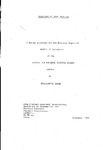OXIDATION OF ZINC SULPHIDE
| dc.contributor.author | BASAK, BODHISATTWA | |
| dc.contributor.other | School of Geography, Earth and Environmental Sciences | en_US |
| dc.date.accessioned | 2013-10-18T10:59:36Z | |
| dc.date.available | 2013-10-18T10:59:36Z | |
| dc.date.issued | 1973 | |
| dc.identifier | NOT AVAILABLE | en_US |
| dc.identifier.uri | http://hdl.handle.net/10026.1/2225 | |
| dc.description.abstract |
A physicochemical study has been made of roasting and sintering processes for zinc sulphide ores. The sulphides are oxidised to metal oxides or sulphates according to conditions, e.g. temperature and time of heating, composition of surrounding gases, whether under static or dynamic conditions. The mechanisms and kinetics of oxidation depend also on surface area, crystallite and aggregate sizes of the materials and the presence of any impurities. Thus, for basic oxidation studies, finely-divided zinc sulphide samples have been precipitated from solution at various pH levels and in the presence of different concentrations of eletrolytes. These experimental conditions have been correlated with changes in phase composition, surface area and crystallite and aggregate sizes during the formation of the precipitates and their subsequent ageing in solution at various temperatures. The oxidation of the two pure zinc sulphides and five ore Concentrates were investigated using the techniques of thermal analysis, gas sorption, X-ray diffraction, optical and electron microscopy. B)y use of D.T.A., the effects of temperature, time, grain size, flow rate and oxygen content of the air on the roasting of the above materials were determined. Changes in specific surface und average crystallite size (deduced from gas sorption) illustrate the influence of the zinc Sulphate on the sintering of the zinc oxide. Further experiments show the effect of small amounts of lead and iron sulphides on the zinc oxide sintering. Results have been correlated with oxidation rates. Attempts have been made to apply the basic researches to problems arising with the industrial roasting and sintering of natural ores such as spontaneous ignition (during shipment, storage and processing) and their poor sintering behaviour and incomplete sulphur removal at higher temperature. Improvements obtained by the use of lime and silica additives in the production of sinters have been investigated. | en_US |
| dc.language.iso | en | en_US |
| dc.publisher | University of Plymouth | en_US |
| dc.title | OXIDATION OF ZINC SULPHIDE | en_US |
| dc.type | Thesis | |
| dc.identifier.doi | http://dx.doi.org/10.24382/1591 | |
| dc.identifier.doi | http://dx.doi.org/10.24382/1591 |
Files in this item
This item appears in the following Collection(s)
-
01 Research Theses Main Collection
Research Theses Main


